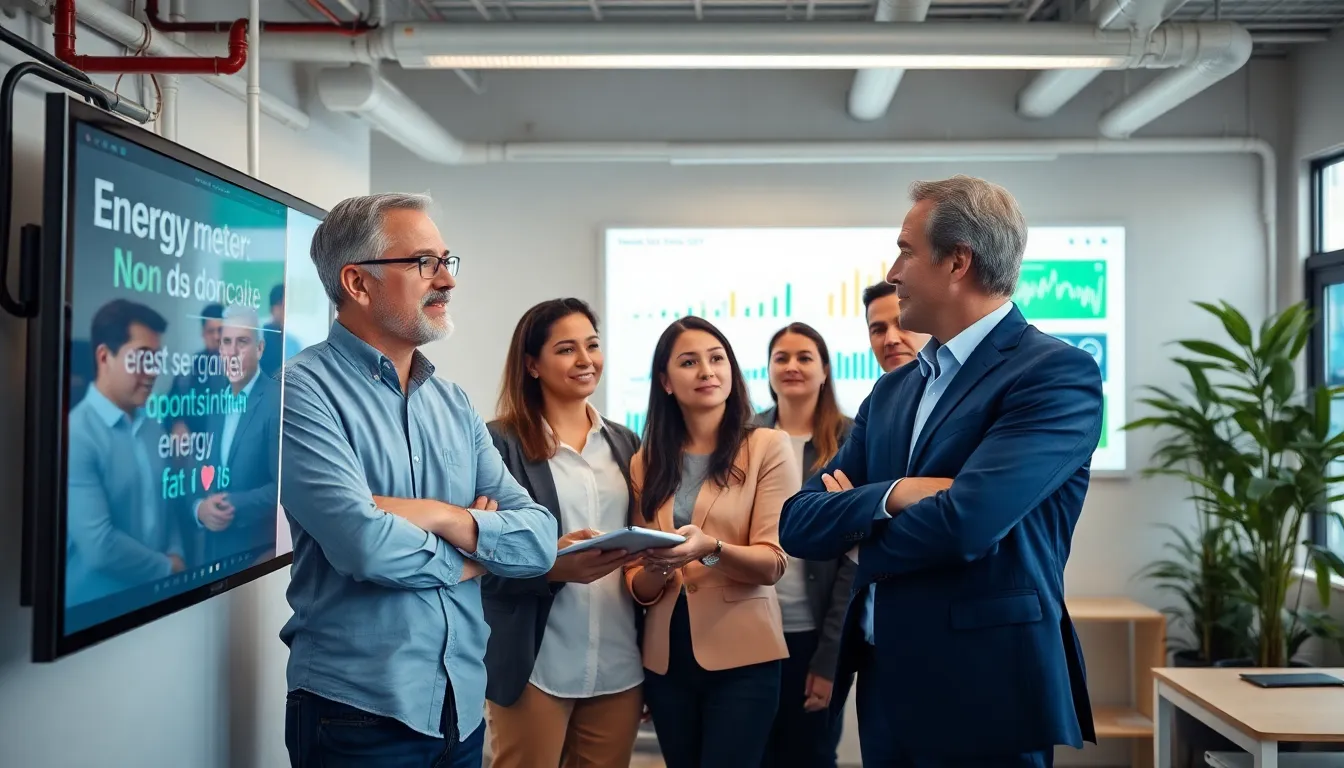In a world where energy bills can rival a small country’s GDP, energy optimization isn’t just a buzzword; it’s a superhero in disguise. Imagine slashing those costs while saving the planet—sounds like a win-win, right? With a sprinkle of smart strategies and a dash of tech-savvy, anyone can transform their energy consumption from wasteful to wonderful.
Table of Contents
ToggleUnderstanding Energy Optimization
Energy optimization refers to strategies aimed at improving energy efficiency while lowering consumption. It focuses on maximizing output from energy sources and minimizing waste.
What Is Energy Optimization?
Energy optimization involves analyzing energy usage patterns and identifying opportunities for enhancement. Individuals and organizations utilize technology and practices to monitor consumption and adjust operations. Techniques such as smart metering and energy management systems play a crucial role in enabling efficient energy use. Through these methods, optimized energy solutions reduce both cost and environmental impact.
Importance of Energy Optimization
Energy optimization holds significant value for both economic and ecological reasons. It leads to substantial cost savings, allowing households and businesses to reinvest in sustainable practices. Optimized energy use contributes to lower greenhouse gas emissions, which benefits the environment. Statistics indicate that organizations prioritizing energy efficiency can reduce their overall energy costs by up to 30%. Enhanced energy practices support long-term sustainability goals and drive innovation in energy technologies.
Techniques for Energy Optimization

Energy optimization involves practical techniques that improve efficiency and reduce costs. Implementing these strategies maximizes energy output while minimizing waste.
Energy Audits
Conducting energy audits helps identify areas for improvement. An energy audit evaluates current consumption patterns, revealing inefficiencies. Organizations can uncover actionable insights to enhance performance and lower costs through this process. Many businesses experience energy savings of 5% to 30% after audits. Regularly scheduling audits allows for ongoing assessments and adjustments to maintain optimal energy control.
Behavioral Changes
Adopting behavioral changes plays a crucial role in energy optimization. Simple practices like turning off lights when leaving a room or unplugging devices when not in use can lead to significant savings. Engagement in energy-efficient habits encourages responsible consumption. Training employees on energy conservation can also impact overall usage positively. Studies show that organizations that foster a culture of sustainability see energy reductions of up to 20%.
Technologies in Energy Optimization
Technologies play a key role in achieving energy optimization, driving efficiency and sustainability in various sectors.
Smart Grids
Smart grids enhance the management of electricity networks. They integrate digital technology with traditional energy systems. This technology allows real-time monitoring of energy consumption patterns. With advanced sensors, smart grids enable quicker response to demand changes. Research shows that smart grid implementations can reduce energy costs by up to 20%. These systems promote distributed energy generation, such as solar and wind, empowering consumers to contribute to energy savings. Increased reliability and reduced outages further underline the benefits of smart grids for energy optimization.
Energy Management Systems
Energy management systems (EMS) streamline energy consumption across facilities. These systems provide comprehensive monitoring and analysis of energy data. EMS helps organizations identify inefficiencies and implement corrective measures. By utilizing analytics, organizations can achieve energy savings of 10% to 30%. Integration with smart devices further enhances the ability to optimize usage in real-time. As a result, energy management systems not only lower costs but also promote environmental sustainability by minimizing waste. Prioritizing these systems positions businesses to meet their energy efficiency goals effectively.
Benefits of Energy Optimization
Energy optimization offers both economic and environmental advantages. Significant benefits arise from employing effective strategies and technologies that enhance energy efficiency.
Cost Savings
Cost savings represent one of the most compelling benefits of energy optimization. Organizations can reduce energy costs by up to 30% through prioritizing energy efficiency. Implementing energy audits leads to actionable insights that result in savings ranging from 5% to 30%. Regular assessments help maintain optimal energy control, allowing for continuous improvement. Simple behavioral changes, like turning off lights and unplugging devices, contribute to further reductions. By training employees on energy conservation, businesses can achieve energy reductions of up to 20%. These efforts not only lower operational expenses but also increase funds available for investment in sustainable practices.
Environmental Impact
The environmental impact of energy optimization is substantial. By implementing these strategies, organizations contribute to a significant decrease in greenhouse gas emissions. Prioritizing energy efficiency can lead to reduced waste and better resource management. Empirical evidence shows that utilizing smart grids can decrease energy costs by up to 20% while promoting distributed energy resources like solar and wind. Employing energy management systems further enhances monitoring capabilities, helping organizations identify inefficiencies. Through analytics, energy savings of 10% to 30% become possible. Consequently, these efforts not only support sustainability goals but also foster innovation in energy technologies.
Challenges in Energy Optimization
Energy optimization faces various obstacles that can hinder effective implementation. Understanding these challenges helps organizations navigate the complexities involved in optimizing energy management systems.
Implementation Barriers
Organizations encounter several implementation barriers when optimizing energy. High upfront costs for upgrading equipment deter many companies from pursuing energy-efficient technologies. Additionally, a lack of skilled personnel to manage these systems creates further complications. Change resistance among employees can lead to difficulties in adopting new practices. Furthermore, insufficient leadership support often results in a lack of commitment to energy optimization initiatives. Organizations need to recognize these barriers and develop strategies to address them effectively.
Technological Limitations
Technological limitations pose significant challenges in energy optimization efforts. Legacy systems often lack integration capabilities with newer technologies, hindering seamless data transfer and analysis. Additionally, unreliable data can arise from outdated monitoring equipment, compromising the accuracy of energy assessments. Limited interoperability among devices leads to fragmented energy management, making it difficult to achieve comprehensive control. Organizations must invest in modern solutions to overcome these technological obstacles, ensuring efficient energy utilization and management.
Energy optimization stands as a vital approach for both cost reduction and environmental preservation. By embracing innovative technologies and implementing effective strategies organizations can transform their energy consumption patterns. The journey toward energy efficiency not only leads to substantial savings but also fosters a culture of sustainability.
As organizations face challenges in this endeavor they must remain committed to investing in modern solutions and training. The benefits of energy optimization extend beyond the bottom line contributing to a healthier planet for future generations. Through continuous improvement and adaptation to new technologies the path to efficient energy use is clear and achievable.








